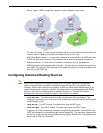
Network > Routing
242
SonicOS Enhanced 4.0 Administrator Guide
• Message Digest – An MD5 hash is used to securely identify the OSPF router on this
interface.
OSPF Area – The OSPF Area can be represented in either IP or decimal notation. For example,
you may represent the area connected to X4:100 as either 100.100.100.100 or 1684300900.
OSPFv2 Area Type – See the ‘OSPF Terms’ section above for a more detailed description of
these settings.
• Normal – Receives and sends all applicable LSA types.
• Stub Area – Does not receive type 5 LSA’s (AS External Link Advertisements)
• Totally Stubby Area – Does not receive LSA types 3, 4, or 5.
• Not So Stubby Area – Receives type 7 LSA’s (NSSA AS External Routes).
Interface Cost – Specifies the overhead of sending packets across this interface. The default
value is 10, generally used to indicate an Ethernet interface. The minimum value is 1 (e.g. Fast
Ethernet) and the maximum value is 65,535 (e.g. pudding).
Router Priority – The router priority value is used in determining the Designated Router (DR)
for a segment. The higher the value, the higher the priority. In the event of a priority tie, the
Router ID will act as the tie-breaker. Setting a value of 0 makes the OSPF router on this
interface ineligible for DR status. The default value is 1, and the maximum value is 255.
OSPF Router ID – The Router ID can be any value, represented in IP address notation. It is
unrelated to the any of the IP addresses on the SonicWALL, and can be set to any unique value
within your OSPF network.
ABR Type – Allows for the specification of the topology with which this OSPF router will be
participating, for the sake of compatibility. The options are:
• Standard – Full RFC2328 compliant ABR OSPF operation.
• Cisco – For interoperating with Cisco’s ABR behavior, which expects the backbone to be
configured and active before setting the ABR flag.
• IBM – For interoperating with IBM’s ABR behavior, which expects the backbone to be
configured before settings the ABR flag.
• Shortcut – A ‘shortcut area’ enables traffic to go through the non-backbone area with a
lower metric whether or not the ABR router is attached to area 0.
Default Metric – Used to specify the metric that will be used when redistributing routes from
other (Default, Static, Connected, RIP, or VPN) routing information sources. The default value
(undefined) is 1 and the maximum is 16,777,214.
Originate Default Route – Controls the advertising of the SonicWALL security appliance’s
default route into the OSPF system on this interface. The options are:
• Never – Disables advertisement of the default route into the OSPF system.
• When WAN is up – Advertises the default route into the OSPF system when the WAN is
online. The default route is always advertised as an External Type 2 using LSA Type 5.
• Always – Enables advertisement of the default route into the OSPF system. The default
route is always advertised as an External Type 2 using LSA Type 5.
Note The following applies to all Redistributed routes: The metric can be explicitly set for this
redistribution, or it can use the value (default) specified in the ‘Default Metric’ setting. An
optional route tag value can be added to help other routers identify this redistributed route
(the default tag value is 0). The redistributed route advertisement will be an LSA Type 5, and
the type may be selected as either Type 1 (adds the internal link cost) or Type 2 (only uses
the external link cost).


















